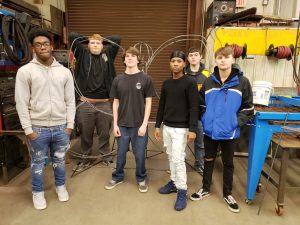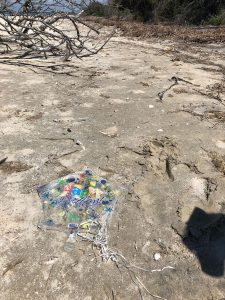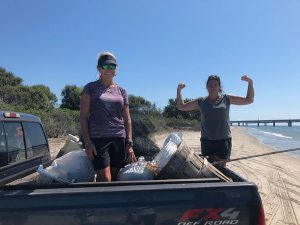What do you do with more than 11,000 balloons that have washed up on Virginia shorelines in the past five years? You make art, of course! On January 19, 35 volunteers arrived at the Suffolk Art Gallery to take part in this imaginative public art project. The project stemmed from a partnership between Keep Suffolk Beautiful, Clean Virginia Waterways of Longwood University, The College and Career Academy at Pruden, The Suffolk Art League, The Suffolk Art Gallery and Suffolk High Schools and was designed to raise awareness of marine debris with a particular focus on balloons. More than 11,000 littered balloons and ribbons were collected by researchers as part of Clean Virginia Waterways five-year study on remote beaches in Virginia. They kindly donated the balloons to Keep Suffolk Beautiful who contacted Thomas Shirk the welding instructor at the College and Career Academy at Pruden to weld sculptures to hold them. Shirk took up the challenge and along with six students produced two beautiful pieces – a butterfly and a sea turtle. Shirk said, “We completed the butterfly and the students’ enjoyed it so much we tried a more challenging sea turtle. These sculptures became the students’ senior projects and they did an awesome job.”
Keep Suffolk Beautiful then contacted art teachers at three public high schools asking for volunteers to come out and fill the sculptures. On high school students, parents and younger volunteers turned up at the Suffolk Art Gallery to sort the balloons into colors and fill the sculptures. Pieces of clam netting found on one of the beaches was cut and sewn to the sculptures making a “skin” to hold the balloons. After 6 hours the two sculptures were finished and ready to go on display.
Linda Bunch of the Suffolk Art League who directed says, “This has been an excellent day and it was great to bring different constituencies together and to incorporate science with art, they are not disparate entities. Science and art can work beautifully together. Art also has a unique way to educate the public and get people thinking.”

Welding Students – L to R Kion Powell, Anthony Moats, Degas Gent, Nathan Martin, Bradley Shallcross, Chase Williams
Wayne Jones Keep Suffolk Beautiful says, “Thank you to everyone who was involved with this art project. It has been 9 months in the making. From the welders and marine debris researchers to the volunteers who showed up today. Everyone was awesome! We want to spread the word about what happens to balloons when released. Pop and drop them but do not let them float away as they end up in our waterways!”
“Balloon-related litter is so preventable,” said Katie Register of Clean Virginia Waterways. “According to a recent study, balloon and their ribbons are in the top three most deadly forms of marine debris. We are delighted that these new sculptures will help reach thousands of people about ways to celebrate without releasing balloons into the air.”
The five-year study on balloon debris was started by researchers Christina Trapani and Kathy O’Hara, both of Virginia Beach. Later, their research was supported by the Virginia Coastal Zone Management Program, the National Oceanic and Atmospheric Administration, and Clean Virginia Waterways based at Longwood University in Farmville, Virginia. From June 2013 to November 2017, 46 balloon-related litter surveys were conducted: Hog Island (N=10), Fisherman Island (N=13), Cedar Island (N=6), Smith Island (N=8) and False Cape State Park (N=9). Survey distances ranged from 0.25 mile to 7.3 miles. The surveys totaled approximately 111 linear miles of remote Virginia beaches. During this period, 11,441 balloons and balloon-related litter items were recorded. You can download the full report for more details.

Researchers and Clean Virginia Waterways starting a survey – Kathy O’Hara and Christina Trapani with Clean Virginia Waterways of Longwood University
Researcher Trapani commented, “people just don’t think about released balloons being litter. We know that most people releasing balloons would never throw trash on the ground but it’s evident when you see mass balloon releases at weddings, funerals, sports games and other events that many don’t consider it littering. But all balloons return to earth and can be very damaging to our wildlife, especially sea turtles and shorebirds.
O’Hara added, “Balloon-related litter was the most frequently found type of debris on the beaches we surveyed! I am glad our collection of littered balloons have been put to an educational purpose.”
Clean Virginia Waterways, the Virginia Coastal Zone Management Program, the Virginia Aquarium, and many other partners worked together to create a campaign that offers fun ways to celebrate…without releasing balloons into the air. Suggestions include bubbles, flowers, glow sticks, and more.
The sculptures can be seen at the North Suffolk Library. Christina Trapani will be giving a presentation regarding balloon debris at the library on February 2nd at 10 a.m.




